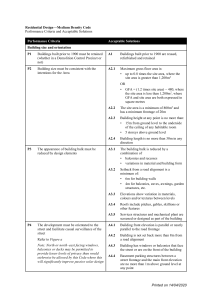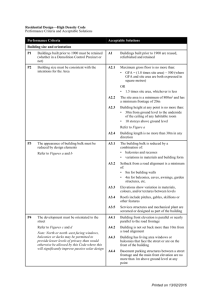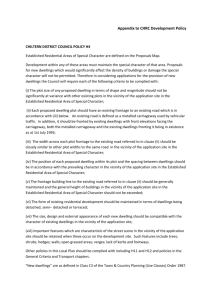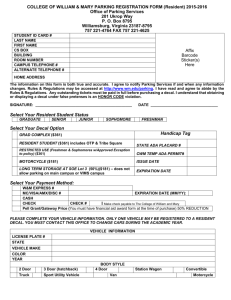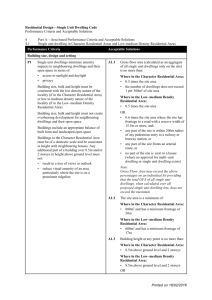Residential Design—Low Density, Character and Low–medium
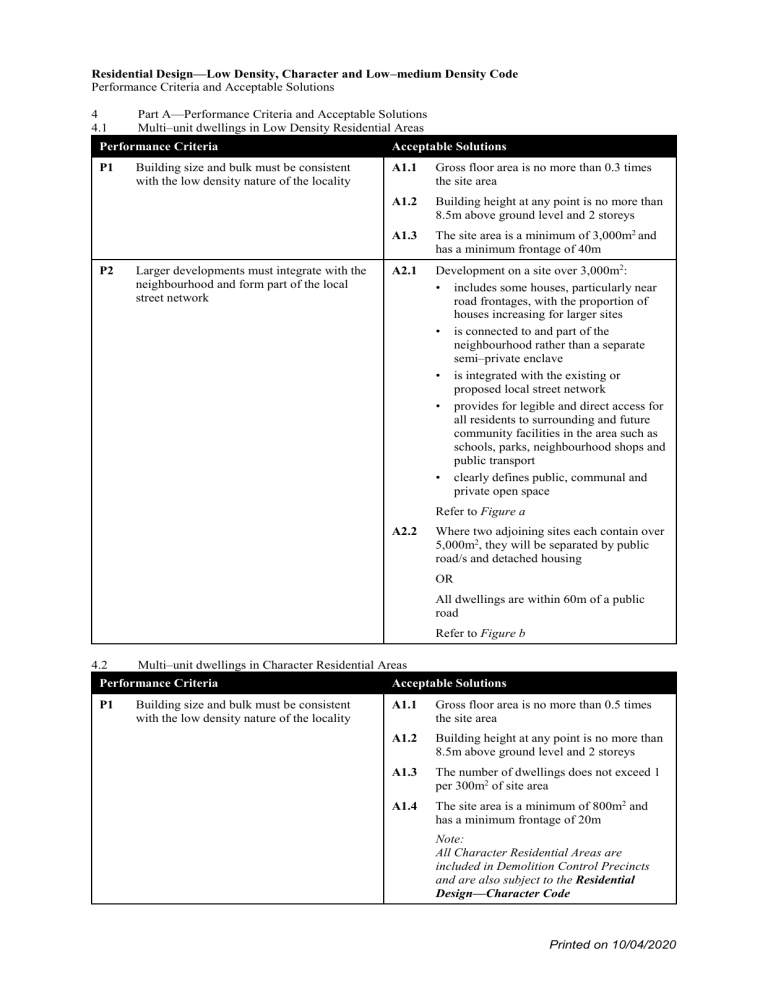
Residential Design—Low Density, Character and Low–medium Density Code
Performance Criteria and Acceptable Solutions
4
4.1
Part A—Performance Criteria and Acceptable Solutions
Multi–unit dwellings in Low Density Residential Areas
Performance Criteria Acceptable Solutions
P1
P2
Building size and bulk must be consistent with the low density nature of the locality
Larger developments must integrate with the neighbourhood and form part of the local street network
A1.1
Gross floor area is no more than 0.3 times the site area
A1.2
Building height at any point is no more than
8.5m above ground level and 2 storeys
A1.3
The site area is a minimum of 3,000m 2 and has a minimum frontage of 40m
A2.1
Development on a site over 3,000m 2 :
• includes some houses, particularly near road frontages, with the proportion of houses increasing for larger sites
• is connected to and part of the neighbourhood rather than a separate semi–private enclave
• is integrated with the existing or proposed local street network
• provides for legible and direct access for all residents to surrounding and future community facilities in the area such as schools, parks, neighbourhood shops and public transport
• clearly defines public, communal and private open space
Refer to Figure a
A2.2
Where two adjoining sites each contain over
5,000m 2 , they will be separated by public road/s and detached housing
OR
All dwellings are within 60m of a public road
Performance Criteria
4.2
Multi–unit dwellings in Character Residential Areas
Refer to Figure b
Acceptable Solutions
P1 Building size and bulk must be consistent with the low density nature of the locality
A1.1
Gross floor area is no more than 0.5 times the site area
A1.2
Building height at any point is no more than
8.5m above ground level and 2 storeys
A1.3
The number of dwellings does not exceed 1 per 300m 2 of site area
A1.4
The site area is a minimum of 800m 2 and has a minimum frontage of 20m
Note:
All Character Residential Areas are included in Demolition Control Precincts and are also subject to the Residential
Design—Character Code
Printed on 10/04/2020
4.3 Multi–unit dwellings in Low–medium Density Residential Areas
Performance Criteria Acceptable Solutions
P1 Development size and bulk must be consistent with the low to medium density of the locality
A1.1
Gross floor area is no more than:
• 0.5 times the site area
OR
• 0.6 times the site area where the site has frontage to a road with a reserve width of
15.5m or more, and:
- any part of the site is within 200m radius of any pedestrian entry to a railway or busway station, or
- any part of the site fronts an arterial route, or
- no part of the site is next to a house
(where no approval for a multi–unit or single unit dwelling exists)
Refer to figure n
A1.2
Building height at any point is no more than:
• 8.5m above ground level and 2 storeys
OR
• 9.5m above ground level to the underside of eaves and 3 storeys where the site has frontage to a road with a reserve width of
15.5m or more, and any part of the site:
- is within 200m radius of any pedestrian entry to a railway or busway station, or
- fronts an arterial route, or
- containing a building over 8.5m above ground level or over two storeys is more than 10m from any lot containing a house (where no approval for a multi–unit or single unit dwelling exists)
A1.3
The site area is a minimum of 600m 2 and has a minimum frontage of 17m
5 Part B—General Performance Criteria and Acceptable Solutions for multi–unit dwellings
Performance Criteria Acceptable Solutions
Building design and setting
P1 The appearance of building bulk must be reduced by design elements
A1.1
The building bulk is reduced by a combination of:
• verandahs
• recesses
• variation in materials, colours, and/or textures including between levels
• variation in building form
Refer to Figure d
A1.2
Roofs include pitches, gables or skillions
A1.3
Services structures and mechanical plant are screened or designed as part of the building
P2 The development must be orientated to the A2 Building has large windows or balconies
Printed on 10/04/2020
street and facilitate casual surveillance of the street
Note:
North or north–east facing windows, balconies or decks may be permitted to provide lesser levels of privacy than would otherwise be allowed by this Code where this will significantly improve passive solar design
P3 Screening and partial enclosure of balconies is limited to provide privacy for neighbours and comfort for residents without resulting in unattractive buildings or an appearance of excessive bulk or restricting opportunities for passive surveillance of the street facing the street
Refer to Figure d
A3.1
Screening of balconies is limited to the side and rear boundaries and the sides of balconies between those units where needed to prevent noise and overlooking of other units or dwellings and recreation areas
A3.2
Street frontages of balconies are not screened or enclosed by shutters, glazing, louvres, or similar permanent stuctures
P4 The front setback must complement the setbacks prevailing in the street
A4.1
In established areas, the front setback is within 20% of the average setback of adjoining buildings
A4.2
In newly developing areas, the setback from a street frontage is a minimum of 3m
A5 Established trees are retained where removal is not required to site new buildings
P5 Landscaping must be consistent with the established landscape character of the area and accommodate the retention of existing vegetation, including street trees
P6 The development must include landscaping that contributes to a pleasant and safe environment and integrates well with the neighbourhood
P7
P8
P9
Fencing and walls must:
• assist the development to be orientated towards the street
• assist safety and surveillance of the street and entry areas
• enable use of private open space abutting the street
• assist in highlighting entrances
The location, height, extent and materials of retaining walls must be designed to minimise visual impact
Development must provide sufficient communal and private open space for residents needs
A6.1
Landscape design allows the overlooking of the street and pedestrian entry areas
A6.2
Landscape design emphasises a clear pedestrian entry point
A7.1
High solid front fences are avoided so that each dwelling unit can observe the street
A7.2
Height of fences/walls on any road alignment does not exceed:
• 1.5m if 50% transparent
• 1.2m if solid
A7.3
Solid front fences/walls above 1.2m high are provided only on arterial or suburban routes and:
• living areas can maintain surveillance of the street
• fences longer than 10m have gates, indentations or detailing to provide visual interest
• the fences are limited to 60% of the frontage where private open space fronts the street
A8.1
Combined height of retaining wall and fence does not exceed 2m
A8.2
Retaining walls are set back from any boundary and are stepped or terraced, so that landscaping can soften visual impact
A9.1
A minimum 30% of the site is provided as open space each with a minimum dimension of 2m
Printed on 10/04/2020
P10 Communal open space for clothes drying and common recreation facilities must be provided where a significant proportion of dwellings do not have access to ground floor private open space
A9.2
A landscape area of minimum dimension of
2m is provided along the full frontage of any road frontage (excluding crossover and pedestrian access only)
A9.3
For a ground floor dwelling, ground floor private open space is provided with:
• minimum area of 35m 2
• minimum dimension of 3m
A9.4
For a dwelling unit above ground level, private open space is provided as a balcony with a minimum dimension of 3m
A10 Where more than 25% of dwellings do not have access to ground floor private open space, communal open space for clothes drying and common recreation facilities is provided with at least one continuous area a minimum of 50m 2 with a minimum dimension of 4m
Character
P11 Buildings built prior to 1900 must be retained whether in a Demolition Control Precinct or not
Privacy and access to sunlight
P12 Habitable spaces must not directly overlook dwellings on adjacent land
Note:
North or north–east facing windows, balconies or decks may be permitted to provide lesser levels of privacy than would otherwise be allowed by this Code where this will significantly improve passive solar design
P13 Development must not significantly reduce daylight to open space and habitable rooms in adjacent development
A11 Buildings built prior to 1900 are reused, refurbished and retained
A12 Where habitable room windows look directly at habitable room windows in an adjacent dwelling within 2m at ground floor level or 9m at levels above ground floor, privacy is protected by:
• sill heights a minimum 1.5m above floor level
OR
• fixed opaque glazing in any part of the window below 1.5m above floor level
OR
• fixed external screens
OR
• fencing to a minimum 1.5m above ground floor level (only applies to overlooking from windows at ground floor level)
OR
• achieving the privacy solution shown in
Figure e
OR
• where screening of decks is required, it is solid translucent screens, perforated panels, or trellises that are permanent and durable and have a maximum of
25% openings
Refer to Figures e , f , g and h
A13.1
The side boundary setback, except for a wall built to the boundary, is a minimum of:
Printed on 10/04/2020
P14 Development must achieve a pleasant, attractive and manageable living environment
Dwellings must receive daylight and allow passage of cooling breezes through habitable rooms
Note:
North or north–east facing windows, balconies or decks may be permitted to provide lesser levels of privacy than would otherwise be allowed by this Code where this will significantly improve passive solar design
Car accommodation and vehicle access
P15 Garages, driveways and parking structures must not visually dominate the street frontage
Vegetation must soften hard stand areas
Refer to Figures i and j
P16
Boundary walls must be limited in dimensions and openings, to minimise the impact on neighbours
Vehicle access and parking must be safe and convenient for residents, visitors and service providers
Resident and visitor parking provision must be provided according to:
• the number, size and type of dwellings proposed
• the availability and acceptability of kerbside parking adjacent to the site
• local traffic or parking management
• the likely preference of the occupier or
• 1.5m for a wall up to 4.5m high
• 2m for a wall up to 7.5m high
• 2m plus 0.5m for every 3m (or part of
3m) over 7.5m height for a wall over
7.5m high
• less than 1.5m where the wall is no more than 3.5m high and no more than 15m long
A13.2
A wall built to a side boundary has:
• a maximum height of 3m, unless it abuts a higher existing or simultaneously constructed wall
• a maximum length of 15m where it does not abut an existing boundary wall
Note:
Where a wall built to the boundary has a height less than 2m measured on the adjacent property, it can extend the full length of the boundary, less any front or rear boundary setback
A13.3
Minimum rear boundary setback is 6m
Note:
Minimum setbacks do not apply to eaves and sun shading devices
A14.1
The optimal number of units are orientated to within 20 o either side of north
A14.2
Orientation of main living area windows to within 20 o either side of north is maximised
A14.3
The majority of private open space has good access to sunlight
A14.4
Window placement and internal layout allows cross–ventilation
A15.1
Carparking is located underground or within a building
A15.2
Vehicle movement areas are broken up by alternative materials, patterns, or threshold treatments. Crossovers are a minimum width of 3.5m
A16 Off–street parking spaces are provided:
• where qualifying for a subsidy for aged persons or persons with disabilities accommodation under any law, 1 car space per 3 dwellings
• otherwise, as in Table 1, the total rounded up to the nearest whole number
Table 1 Vehicle spaces for different dwelling sizes
Dwelling unit size
(gross floor area)/ number of bedrooms
Average vehicle spaces per dwelling
Printed on 10/04/2020
P17 target market
Note:
Resident parking provision may be reduced from the rate specified in the Acceptable
Solution where public transport is available within a reasonable walking distance or where low demand is indicated
Vehicle access and parking design and location must minimise impacts on neighbouring dwellings
Noise disturbance must be mitigated by parking area location and fencing
P18 Vehicle access to the site and neighbouring sites must not impede the traffic flow on arterial routes
The development must have safe and convenient vehicle access to dwellings and the street network
Managing light and noise impacts
P19 Light nuisance must be minimised
Location
Small (<75m 2 ) or 1 bedroom
A (1)
0.75
B (2)
1
Other 1 1.25
Plus per dwelling for visitors 0.25 0.25
Note: Tandem parking may be used where 2 spaces are provided for 1 dwelling
(1) A means any part of the site is within 200m of a pedestrian entry to a railway station, busway station, or ferry terminal, or within 100m of a major road except where the site has its only access to a road where on–street parking restrictions apply
(2) B means any other circumstances
A17.1
Vehicle parking is:
• screened to minimise reflection of car headlights onto dwelling windows and attenuate noise
• lit at night
• separated from habitable windows to minimise noise and fumes disturbance
A17.2
Vehicle parking structures are designed and located:
• behind the building setback, or
• behind or below the building so they are not visually dominant from a public street
Refer to Figure k
• to be compatible with overall building design in terms of height, roof form, detail, material and colours
• as close as possible to the dwellings to be served
A17.3
The location of visitor parking is discernible from the street
A17.4
Acoustic screening is provided next to any vehicle movement or vehicle parking areas along the side or rear boundary
OR
A 2m wide vegetated buffer is provided next to any movement or parking areas along the side or rear boundary
A18.1
A18.2
The proposal does not use an arterial route for vehicle access to the site
Vehicle access is provided to abutting sites that only have frontage to an arterial route, to facilitate access to the abutting site via an alternative street
P20 Noise from the development must not affect existing or likely future dwellings on adjacent
A19 Outdoor lighting complies with the requirements of the AS4282—Control of the
Obtrusive Effects of Outdoor Lighting
A20.1
Vehicle movement areas are located a minimum of 3m from any adjoining
Printed on 10/04/2020
P21 land unreasonably
Exposure of new dwellings to noise must be minimised dwellings, or are provided with acoustic screening to the boundary
A20.2
Any air conditioning plant is located toward the centre of the site
A20.3
Communal open space is located a minimum of 3m from adjoining dwellings or provided with acoustic screening
A20.4
The development complies with the Noise
Impact Assessment Planning Scheme
Policy
A21.1
Noise impacts on dwellings located within
150m of a Centre, Industry Area, rail corridor, road corridor (suburban routes, motorways and arterial routes) or within a noise exposure of 20ANEF or greater are mitigated to comply with the requirements of the Noise Impact Assessment Planning
Scheme Policy
Refer to Figure m
Utilities and services
P22 Waste disposal and collection areas must be unobtrusive, and adverse impacts on neighbouring properties must be mitigated
A22.1
Garbage bin storage and collection areas are located on site and are screened from view
A22.2
For buildings of ten or more units, on–site bin storage:
• is not located within 5m of a property boundary
• is located where it can be accessed by refuse collection services
• is located within the main building
Affordable housing outcomes
P23 Low cost housing is encouraged through development bonuses but only if it does not compromise local amenity
A23 If accomodation provides lodging for permanent residents or is administered by a housing cooperative, a Government or
Council agency or charitable orginisation to provide low cost, special needs housing or aged care accomodation for at least 10 years and height limits and setbacks are complied with:
• the plot ratio of low cost and special needs housing may exceed the plot ratio applicable to multi–unit dwellings in the area
• on–site parking may be less than otherwise stated in this Code provided it meets expected requirements
Where in a Potential Development Area and on a site affected by a habitat area and ecological corridor or landscape feature, as identified in a Local Plan
P24 Siting of buildings must:
• minimise disturbance to habitat areas and ecological corridors
• avoid interruption to public views of a scenic feature
• protect physical landscape features
A24.1
The habitat areas and ecological corridors or landscape features are retained in common property
A24.2
Common property areas containing habitat areas and ecological corridors or landscape features is to be used for conservation purposes only. The area is not to be cleared
Printed on 10/04/2020
P25 to ensure their long term viability
Appropriate site planning and procedures must be undertaken to ensure the retention of significant vegetation or contain hard or recreation surfaces such as clothes drying areas, swimming pools, driveways or tennis courts
Note:
Further guidance on the design of urban development adjacent to ecological corridors and lands can be gained from
Council’s Ecological Assessment Guidelines
A25 Where the site is covered by a Natural
Assets Local Law (NALL) Significant
Vegetation category; buildings, carparking, common areas and driveways are located to enable the retention and long term performance of the significant vegetation
Where in a Potential Development Area and on a site affected by landscape feature, as identified in a
Local Plan
P26 Vehicular access exceeding a gradient of 1 in
6 must be unobtrusive, constructed to prevent erosion and utilise materials that maintain the visual values of the area
A26.1
Vehicular access exceeding a gradient of 1 in 6 is sealed with natural, earthy or dark coloured materials
A26.2
Vehicular access follows rather than crosses contour lines as much as possible
P27 Fencing must be low key, not visually prominent and integrate with desirable elements of landscape design in the road reserve
P28 Building materials and colours must integrate with the existing colours and patterns of the landscape and minimise the impacts of the building on the visual amenity of the locality
A27 Fencing does not exceed 1.5m in height and is at least 75% transparent
A28.1
External building colours are subdued and natural ie grey, brown or green with low light reflectivity
A28.2
Metal roof cladding is non-reflective and colour bonded or painted in subdued and natural earthy colours
A28.3
Roof pitches and shapes respond to landscape forms
P29 Building location must minimise disturbance to natural patterns of vegetation and ensure integration with the environment
A29.1
Buildings are located a minimum 15m vertically below any ridge line
A29.2
Private open space and common areas enhance natural pattens of vegetation, physical landscape and shade provision
A29.3
Site utilisation and building footprints are minimised
A30 The mass of buildings is minimised by variations in wall and roof lines
P30 Design elements must reduce the mass of the building and be of a scale compatible with the landscape and scenic features of the locality
P31 Buildings must be screened from view or sympathetic to the form and line of the surrounding landscape
A31 Vegetation is used to screen built structures and areas cleared as a result of excavation, when able viewed from the road alignment or other public viewing areas
Printed on 10/04/2020
While every care is taken by Brisbane City Council to ensure the accuracy of this extract of the code,
Council make no representations or warranties about its accuracy, reliability or completeness and disclaim all responsibility and all liability (including without limitation, liability in negligence) for all expenses losses and damages (including direct and consequential damage) and costs that may be incurred as a result of the document being inaccurate in any way and for any reason.
Printed on 10/04/2020
